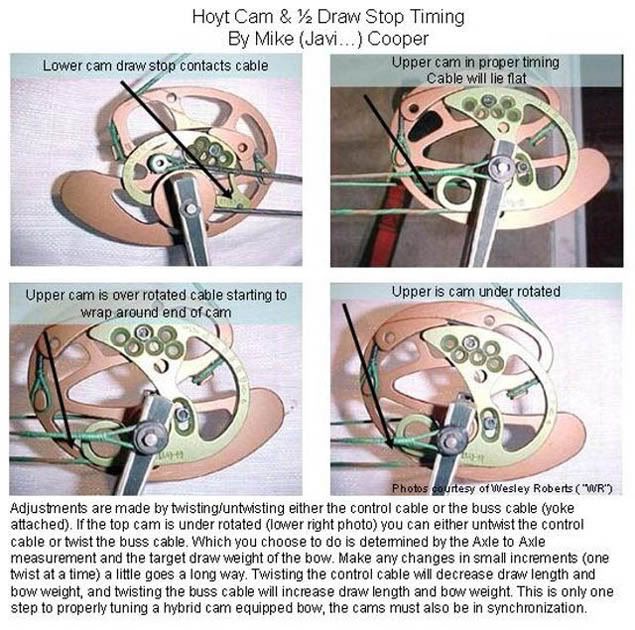Post by BT on Feb 2, 2008 17:14:47 GMT -5

Hybrid Cam Sync & Timing
By Mike Cooper
The timing system on the hybrid cams is somewhat different from other systems.
The cams need to be in synchronization and in draw stop timing; these are two entirely different issues but interconnected. It is possible to have the cams in sync, but not in time and visa versa.
The string is for all practical purposes, just along for the ride, the buss cable (yoke) controls the bow, and it is used to set the axle to axle (limb) preload and takes most of the weight of the limb deflection at full draw. The control cable (slave) ties the two cams together so that they rotate at the required speeds.
The reference marks or holes (depending on the cam) are there to provide a visual reference to cam synchronization not draw stop timing. I find that tiller is a more precise indicator of cam sync; if the limbs are bottomed out the tiller will reflect the position of the cams better than the reference holes (marks).
To adjust the cams, I back the string off until I’m sure it isn’t affecting the axle to axle (usually ten twists will do) then adjust the buss cable to bring the axle to axle measurement to a ¼” longer than the specifications for that particular cam/limb combination (see Hoyt tune charts). The control cable should be used to sync the rotation of the cams while doing this. If the cams are in sync at this point the reference holes will be equidistance from their respective cables and the tiller will be even (limbs bottomed out).
Now is the time to adjust the draw stop timing, using a draw board or similar device (you can draw the bow and have someone else look at the cams) when the bottom cam’s draw stop is just touching the buss cable, the control cable should lay flat in the groove of the top cam. If the cam is under rotated you can put a twist in the buss or untwist the control, I determine which I do by the draw weight and draw length of the bow. Shortening the buss cable will lengthen the draw and increase the draw weight. Shortening the control cable will decrease the draw length and decrease the draw weight.
At this point, I measure the draw length (using AMO standards); it should be long and the draw weight should be higher than spec for the bow. I will then twist the string to bring the draw length to spec; this should also bring the draw weight and axle to axle into spec.
I double check everything and tweak a half twist here or there to fine tune it.
Finally I use the hybrid cam creep tuning method to set the bow to my shooting style.
If you follow this method you will have a very solid wall and the bow will be practically vibration free.
A note: the regular cam & ½ should be tuned in the “D” draw length slot for best performance. You can then set the module to your required DL and tweak the DL using the string.
**The measurments for the Hoyt regular cam 1/2 i.e draw weight, axle to axle, and brace height are taken in either "C" or "D" slot... while the change isn't significant there are differences so I recommend that you "use" the slot as deginated by Hoyt (example: www.hoyt.com/technical/charts...4_ultratec.inc 2004 UltraTec w/XT2000 limbs is spec'ed to be in "D" slot of the module). Once you have the bow set to all specs and the cams in time and sync, then you change the module to the corrct draw length for you...
** If the Hoyt chart says "C" then use "C", however I find most use "D" instead
**Axle to axle and brace height as published is cam/draw length specific you need to check with Hoyt; if it is not listed in their tuning charts on the Hoyt web site. Also be avised that those numbers are REFERENCE ONLY and not a number that must be reached for optimum performance.
__________________
Creep or fine tuning the Hoyt Cam & ½
It is a variation on the old stand by Creep tuning methods…
With the tiller set to even (limb bolts bottomed and backed out the same on both limbs to your shooting weight) Set the timing as close as you can by eye.
I like to start with my sight zeroed at 20 yards.
Using ½ or ¾ inch masking put a horizontal line on your 20 yard target.
Shoot 3 or 4 arrows aiming at the tape, be sure to draw only to the wall do not pull into the limbs. Only use your good shots; the bad ones don’t count.
This is where the Cam & ½ differs from the two cam bow in creep tuning. Since there is no real valley you can’t creep into it.
Now shoot 3 or 4 more arrows at the line, while drawing your bow hard into the cams (you’re over rotating the cams just a bit) this is what most people describe as the mushy felling on the cam & 1/2. Again use only your good shots.
If your bow is in perfect time all your shots will hit the line, and the mushy feeling will be almost unnoticeable. If the shots fired while pulling hard into the cams hit high, apply a ½ twist to the control cable.
If the shots fired while pulling hard into the cams hit low apply a ½ twist to the buss cable.
Repeat until all shots hit the tape….
If you want to tune it even closer; repeat at 30 or 40 yards….
______________
